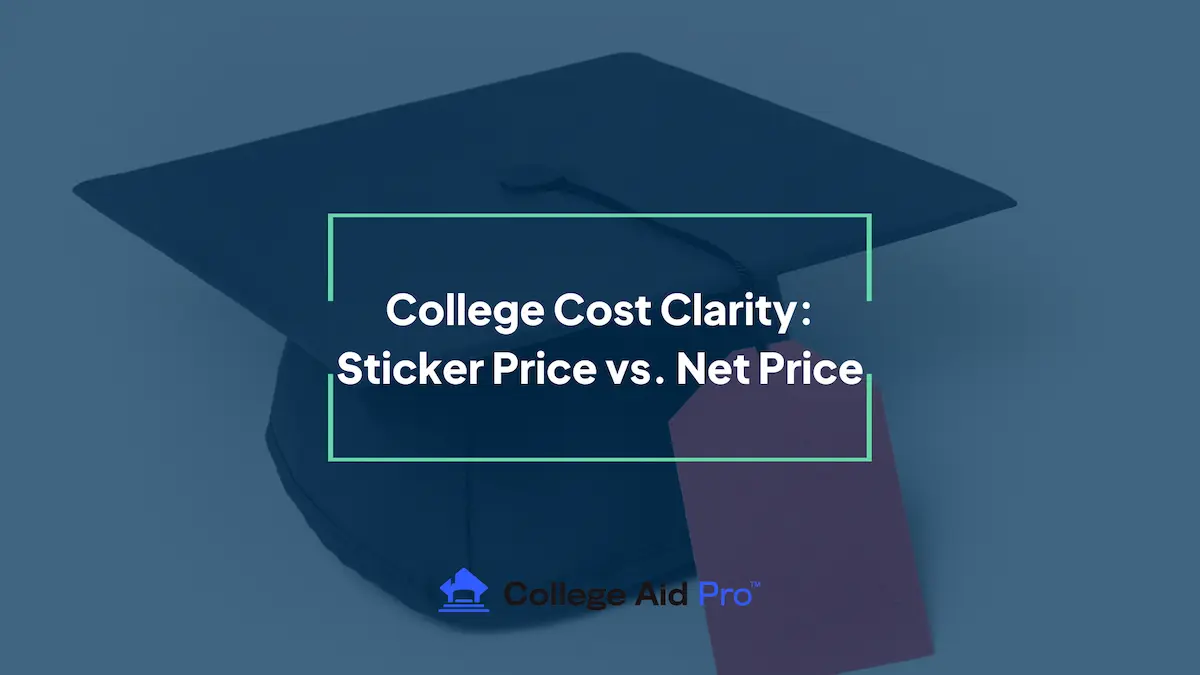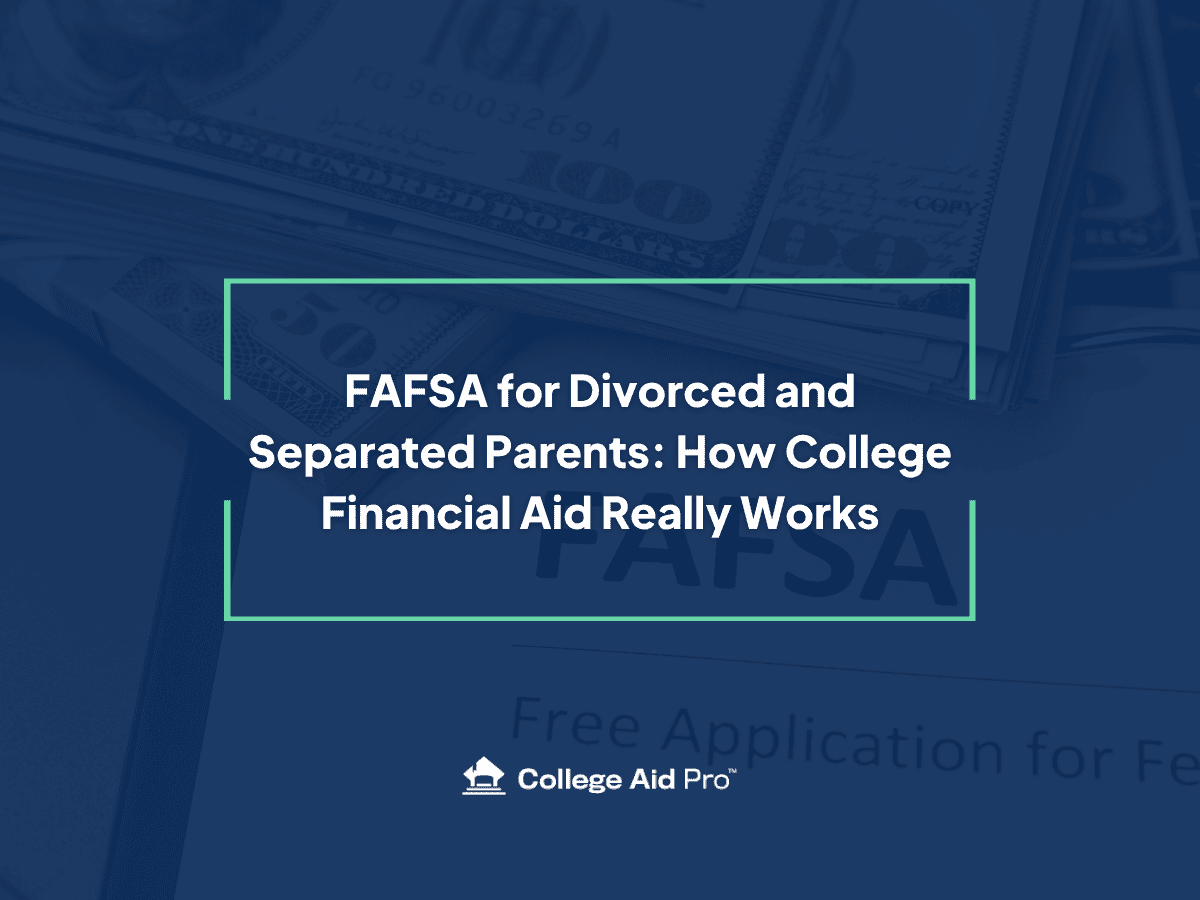Sticker Price vs Net Price: Making Sense of College Costs

Are you a parent of a high schooler getting ready to embark on the exciting college search journey? Congrats! You’ve made it to the next chapter in your child’s quest for independence and “leaving the nest.” It’s a big deal and possibly an even bigger shock to your system at how nuanced and sometimes complicated this college process has become. So take a deep breath and know that you can do this. With some strategy, knowledge, and guidance before long you’ll be celebrating college acceptances. But before we get there, let’s begin with a quick tutorial on what I consider the most important factor in finding your college fit – the cost to you.
In this blog we’ll walk you through the key differences between the terms “sticker price” and “net price.” Both are important to understanding the real cost of higher education and how it effects your bank accounts.
Sticker Price – The Initial Shock
Let’s start with the infamous “sticker price.” This is the published cost of attendance, sometimes referred to as COA, that you often see on a college or university’s website or brochure. The sticker price includes tuition, fees, room, board, textbooks, and other estimated expenses for an academic year. For many parents, the sticker price can be a source of sticker shock. It’s not uncommon to see figures that exceed $70,000 or even $90,000 per year.
While these numbers might seem overwhelming, it’s important to remember that they do not reflect what most families end up paying. The sticker price is a starting point, not the final cost.
The sticker price is made up of two different types of costs – direct costs and indirect costs. The direct cost is the amount you pay to the actual school when you see your college bill at the beginning of each semester. Direct costs include tuition and fees, and room and board. Note that if your student lives off campus without a meal plan, this will move from a direct cost to an indirect cost. Indirect costs are what you pay for expenses required to be a student at a particular school, but you aren’t paying this money directly to the college.
Indirect costs include books and supplies, transportation to and from school, and other costs associated with college life. Each school estimates average amounts for indirect costs because they will vary student to student. Pro tip: Look for ways to lower those indirect costs in order to save money!

Direct Costs:
-
- Tuition and Fees: This is the core cost of enrollment and varies significantly between institutions. Public colleges are generally more affordable than private colleges.
- Room and Board: The cost of on-campus or off-campus housing, as well as meal plans, contributes to the sticker price.
Indirect Costs:
-
- Books and Supplies: Textbooks, course materials, laptops, and other supplies are factored into the initial cost. Remember this amount depends on course requirements. You may need things like computer programs and uniforms, or you may be able to purchase textbooks second hand.
-
- Transportation: This could be drastically higher or lower than the estimated amount depending on how far away you live from school. Are you driving or flying?
-
- Miscellaneous Expenses: Most schools estimate some extra for this category as other costs associated with college life.
Net Price – A Realistic Perspective
Now, let’s delve into the concept of “net price.” The net price is the amount you’ll ACTUALLY pay for college after factoring in financial aid and scholarships. Usually, it’s a much more realistic and manageable representation of the true cost of attending a specific institution than the sticker price.
The net price considers your family’s financial situation, including income, assets, and household size. Colleges use this information to calculate your Student Aid Index (SAI). Your SAI is what college financial aid offices use to determine your eligibility for need-based financial aid. The lower your SAI, the more financial aid you’re likely to receive, ultimately reducing your net price.
Understanding the details of how the net price is calculated can help you grasp the nuances:
- Student Aid Index (SAI): As defined by the FSA office, “The Student Aid Index (SAI) is an eligibility index number that a college or career school’s financial aid office uses to determine how much federal student aid the student would receive if the student attended that school.” It is determined by a formula established by the federal government and is based on your family’s financial information.
- Need-Based Aid: Colleges may offer need-based financial aid, such as grants, scholarships, and work-study programs, to bridge the gap between the sticker price and your SAI.
- Merit-Based Aid: Some colleges also provide merit-based scholarships, which are awarded to students based on their academic, athletic, or artistic achievements.
- Private Scholarships: Students can apply for numerous private scholarships from organizations, foundations, and corporations to further reduce college costs.
Why the Difference Matters
Understanding the distinction between sticker price and net price is essential for several reasons:
- Budgeting: Knowing the net price of a college is crucial for budgeting purposes. It allows you to make an informed decision about whether a particular school is within your family’s financial means. By comparing net prices, you can determine which institutions offer the best value for your money.
- Comparing Options: Comparing the net prices of different colleges can help you identify affordable choices and prioritize them during the application process. Don’t be discouraged by a high sticker price; you might be pleasantly surprised by the net price. This information empowers you to create a list of colleges that align with your budget.
- Financial Planning: By considering the net price, you can develop a more accurate financial plan for your child’s college education. This might involve saving, seeking additional scholarships, and making informed choices about student loans. Understanding the net price also allows you to set realistic expectations for your child’s potential student loan debt.
How Do I Find the Net Price?
To find the net price for a specific college, visit the institution’s financial aid webpage. Most colleges have a Net Price Calculator that allows you to input your family’s financial information and estimate your net cost. Additionally, you should complete the Free Application for Federal Student Aid (FAFSA) to determine your eligibility for federal and state aid programs.
Here’s a step-by-step guide to finding the net price for a college:
Step 1: Gather Financial Information
Collect your family’s financial information, including income, assets, and household size.
Step 2: Use a Net Price Calculator
Visit the college’s website and search for the Net Price Calculator or create a free MyCAP account and use our software for more accurate estimates than most school net price calculators. Input your financial data to receive an estimate of your net price.
Step 3: Complete the FAFSA
Submit the Free Application for Federal Student Aid (FAFSA) online. This form is essential for determining your eligibility for federal financial aid programs, including grants, work-study, and federal student loans.
Step 4: Review Financial Aid Offers
Once you receive admission offers from colleges, review the financial aid packages they offer. These packages will provide a breakdown of the scholarships, grants, and loans available to your child.
Step 5: Compare Net Prices
Compare the net prices of the colleges your child has been admitted to. This will help you make an informed decision about which school is the most affordable option.
As you guide your high schooler through the college application process, keep in mind that the sticker price is just the beginning. The net price, which is a discounted sticker price, provides a more accurate representation of what you’ll pay. Understanding the difference between the sticker price and net price is not only about financial planning but also about empowering you and your child to make informed choices and set realistic expectations about college pricing and what your student will pay for their college education.
Remember, college is an investment in your child’s future, and with the right financial strategy, it can be a wise one. By taking advantage of available resources and making informed decisions, you can pave the way for your child’s success while keeping your family’s financial well-being in check.



